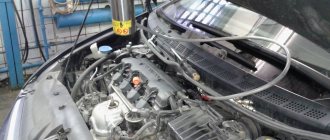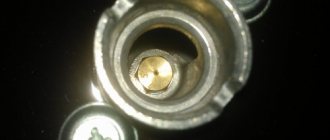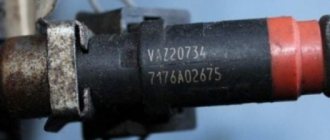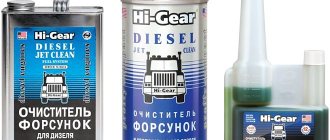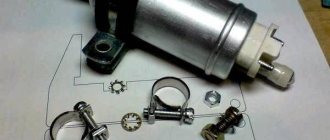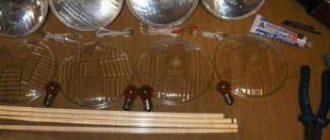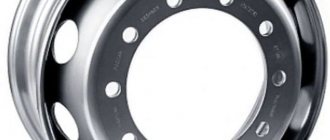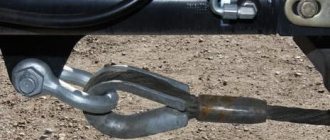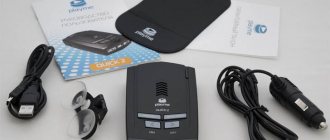Cars admin26.02.2020
Adjusting the stroke of the gas injectors DIGITRONIC bfc 30/37
It all started with the fact that it was time to change the rubber rings on the rods, I changed them, and accordingly the rod moved out of order, calling the office, they charged as much as 1500 rubles for a 15-minute task. I’m not a rich person, and I’m not stupid, I read a lot of literature on the Internet, bought a used dial indicator for 500 rubles, went to a turner, he turned out a part (adapter for 300 rubles) for the ramp, it fit as it should, took a 12 volt 300 power supply micro ampere, bought a chip for 90 rubles in bi bi* from reverse, soldered it a little.
How it works ; the injector coil is supplied with 12V power for no more than 25 milliseconds, the valve is activated, rises and releases gas, we need to measure the valve stroke with a *micrometer* indicator, in simple terms* I set the stroke to 0.45 millimeters, the main thing is not to overextend the current to the coil, it will burn out, maximum half seconds, the coil has a resistance of 3 ohms. When I measured it with a multimeter it was 4 ohms, perhaps it drops to 3. By the way, it is set with a hexagonal bolt on top of the coil.
An article for those who need it, or who want to save money. By the way, + and - don’t matter, at least on these forces.
When operating gas fueled vehicles, drivers often encounter incorrect operation or breakdowns of the gas equipment. The efficiency of this equipment largely depends on the serviceability of gas injectors. Their operation takes place under conditions of high temperatures and sometimes low-quality fuel.
Owners of gas-powered vehicles are advised to know how to repair, clean and adjust 4th generation LPG gas injectors with their own hands. This will help in some situations and save money.
General information
Gas injectors are special gas equipment units that are responsible for the dosage of fuel, essentially being high-speed valves. Thanks to their proper operation, the required gas-air mixture ratio in the internal combustion engine is ensured. Such mechanisms began to be used in the 4th generation of HBO.
Some of the most popular are stock models from the companies Valtek (Valtek), Rail (Reil), Digitronic (Digitronic), OMVL (OMVL), Lovato (Lovato). Their undoubted advantage is that they are easy to repair, which consists of washing, replacing the repair kit and adjusting, unlike non-separable injectors such as BRC (BRS), Barracuda (Barracuda) and the like.
Signs and possible causes of malfunctions
Symptoms of a malfunction of one or more injectors may include:
- high fuel consumption;
- deterioration of the dynamic characteristics of the machine;
- unstable engine operation, internal combustion engine is tripping (one or a couple of injectors do not work);
- dips when pressing the gas pedal;
- malfunctions of various sensors, appearance of “Check engine” errors (for example, MAP sensor);
- knocking in the injectors (they “click” loudly);
- gas leaks through injectors (pouring/poisoning);
- The car stops idling and the injectors do not turn on.
The reasons for this may be:
- wear of the damper rubber rings on the valve stems (this causes the injectors to knock);
- development of the seat (seat) of the valve or its locking rubber;
- wear of the rod (also called piston, anchor) or sleeve (also called core, cylinder, bulb);
- armature jamming in the cylinder;
- weakening of the elasticity of the piston return spring;
- failure of the electromagnetic coil (solenoid);
- violation of the integrity of the electrical wiring.
All of the above reasons can appear naturally or due to low-quality parts, untimely maintenance of gas equipment, or violation of the rules for installing injectors. For example, if gas filters are not replaced on time, gas condensate (oily liquid, water, dirt) can get into the injectors, which can cause them to jam or accelerate wear.
Also, the horizontal position during installation affects uneven wear (ellipse) of the liner body and rod. And simple non-compliance with the rules for installing wires (twisting instead of soldering, mixing, improper fastening) can cause problems over time. One way or another, injectors of this type rarely survive up to 70 thousand km. mileage without repair (repair kit change). It all depends on the conditions of their use.
First, a little introduction...
Everyone knows that it’s not just gasoline and diesel fuel that we’re running out of. A long time ago, gas stations learned to “inflate” our brother, not with gas, but with air, mixing various nasty things into the gas fuel, which adversely affects the condition of the gas equipment and the entire engine as a whole.
I recommend: Refueling a car with LPG: how to refuel with gas correctly and safely?
So one day it was noticed that the engine was unstable on gas; when switching to gas, the engine stalled, and there was simply no idle. Among other things, the dynamics deteriorated, traction disappeared, gas consumption increased and dips appeared during acceleration. Moreover, the above-described “glitches” appeared, as a rule, “in the cold”. Some time after the engine warmed up to the optimal temperature, all these “sores” practically disappeared.
The problem did not allow me to live and drive any car. Having scoured the Internet, I found similar cases, as well as reviews from those who “overcame” this problem. Suspicion fell on the filter (how to change filters and drain condensate is written here and here), as well as gas injectors. The filters were replaced, by the way, during the replacement a large amount of resin was discovered in the filter elements, this alarmed me and made me think. If there is so much “poop” in filters, then what is in gas injectors? The decision was made - it was necessary to clean the gas injectors, as well as their further calibration. What came of it - read on...
Topical: How to drain condensate from a gas reducer?
Do-it-yourself step-by-step repair of gas injectors
To repair 4th generation LPG injectors type Valtek or OMVL, you will need to remove the entire rack assembly:
- shut off the gas supply to the cylinder. To do this, you need to tighten the corresponding multi-valve tap;
- start the engine for a while to remove any remaining fuel from the system;
- disconnect the battery terminals;
- disconnect the hoses and power supply;
- Unscrew the vibration dampers and remove the gas train.
Disassembly and washing
In order to disassemble and wash the nozzle (let’s look at the example of Valtek type 30), you need to:
- Using a 12mm wrench, unscrew the calibration jets/nozzles from the bottom of the ramp;
- Using round pliers or a screwdriver, remove the retaining rings of the coils;
- remove the coils;
- unscrew (key 14) the valve cores and remove the pistons from them.
Next you need to check for wear: rubber parts, valve seats and rods with liners.
Important! If you plan only to clean gas injectors, without replacing parts, you must assemble all the elements in their places without mixing them up. Also, in this case, it will help to extend the life of the injectors - if you turn over the worn out locking rubbers on the rods .
Carry out troubleshooting of parts. Identify squashed rubber rings, bumpers and seals, and also check the cylinders and anchors for wear. The valve rubber should not have large indentations from the seat. The saddle also tends to shrink over time. Discard unusable parts.
Then clean the injector parts from dirt deposits; this can be done conveniently using a rag or cotton swabs. Using carburetor cleaner (carbocleaner), acetone, gasoline or other similar products. Rubber products (if a decision is made not to change) must be removed and cannot be washed with aggressive substances. Rubber can swell from such compounds. For the same reason, it is not advisable to clean/rinse injectors (non-removable) such as Hana, Barracuda, Brc, the effect of such cleaning does not last long, if they work at all after that.
Selecting and replacing a repair kit
The repair kit for gas injectors, as a rule, is equipped only with rubber products (RTI), a rod and a spring, for one injector or the entire ramp. You can also buy a complete set of parts (rods with core bodies and return springs assembled). Everything happens separately. On average, the price of a standard repair kit for one rail will be about 500 rubles.
Based on numerous reviews from drivers, for Valtek injectors, and these are LPG Tech, GREEN GAS (Green Gas), Atiker (Atiker), WentGas (ventgas), Tomasetto (Tomasetto), Yota (iota), Digitronic (Digitronic) even Lovato ( Lovato), original repair kits from RAIL are best suited.
The peculiarity of r/k is that their piston has a hole in the body; this solution reduces the effect of the syringe. If the choice fell on another manufacturer, you should pay attention to the lack of magnetic properties of the metal parts (this should not happen), dimensions, weight.
The entire replacement process involves assembling the mechanism block in the reverse order:
- if the pistons are not changed, then remove them from their seats on the rods and replace the rings (rubber dampers/bumpers);
- install (new/old) armatures and return springs into the sleeves;
- change the O-rings of the rod stroke adjusting screw, as well as under the coil and core;
- screw the sleeves into the rail;
- put on the coils and retaining rings.
All seals are recommended to be used once. The outlet calibration nozzles/fittings do not need to be installed at this stage.
How to adjust gas injectors
Adjustment of 4th generation Valtek type LPG gas injectors comes down to adjusting the stroke of the rod for uniform dosing of fuel.
There is a calibration option, using a factory or home-made stand for checking and calibrating gas injectors; not even all service stations have such equipment.
Daewoo Nexia is just a machine › Logbook › HBO — 4 — part 3 — Installing injectors, inserting fittings
I continue the installation of HBO - 4
- BARRACUDA injectors (4 cylinders, 1.9 ohm)
- FAGUMIT gas hose Ø5
- 1 m
96352947
— Intake manifold gasket (
GM
) or equivalent
P1L-C001G
— Intake manifold gasket (
Pmc
)
It's time to cut in the fittings and install the injectors
1.
The fitting must be cut perpendicular to the air flow passing inside the manifold, or at an angle
along the flow 2.
The cut-in fitting must be directed into the collector
3.
The distance between the taps and the gasoline injectors must be the SAME!
4.
The length of the rubber hoses between the fittings and the gas injectors must be the SAME! Everything is perfectly described and shown here
For normal insertion, you need to REMOVE the intake manifold. We remove it, we see the stuck gasket - all this needs to be cleaned!, the same on the manifold itself
We mark the drilling location on the manifold - the gas from the fitting should fall into the middle of the channel. That is, all fittings should be on the same line, and approximately inclined at 45 degrees, because there are gas pumps in the middle and they will interfere
Since at 1.5 there are 16 cells. it is very difficult to place the injectors somewhere due to the shape of the manifold and so that the length of the hoses is as short as possible. Of the FOUR options proposed by Urabus87 - and long discussions, we settled on the fact that the fastening of the injector strip will also CUT into the manifold
) Barracuda injectors will stand vertically, although these injectors can be placed “lying”, that is, horizontally
We drill with a drill to 3, then to 5 and cut the threads. We “set” the fittings and studs on high-temperature sealant
We cut off the hoses of the same length - mine turned out to be 16 cm, it could probably be even 2 centimeters shorter
We estimate, determine how we will bend the hoses
Here you can clearly see that there must be a reserve length of the hose so that the injectors can be serviced or something else
source
Successful products Valtek Spa Unipersonale
The Italian company Valtek Spa Unipersonale, created in the 90s of the last century, produces high-quality gas equipment sets that have a long service life. Valtec injectors meet quality standards of the European Union and America.
Having its own research laboratory allows the company to produce safe, high-tech products, which are mainly exported.
The basis of Valtek gas injectors is a rod made of durable metal with a rubber tip. This design eliminates gas leakage. The electromagnetic coil is secured with a retaining ring. Special screws allow you to adjust the fuel supply; they have nothing to do with fixing.
Ramps are available that include 2, 3, 4 nozzles. You can choose products that match the number of engine cylinders.
The ramp includes a set of nozzles for the manifold, but calibration fittings, the diameter of which can be from 0.75 to 3.0, must be purchased separately. The diameter can be selected according to the table or drilled according to the power of the car’s power plant.
Calibration of Valtek injectors is carried out on your own and at a stand in a car service center.
With a cylinder power of about 40 hp, the diameter of the nozzles for gas injectors should be from 2.7 to 2.9 mm.
Valtek gas injector repair kit is affordable.
Price of gas installations
The cost of a set of fourth-generation gas equipment depends on the chosen manufacturer, as well as the characteristics of the car engine.
The price of HBO-4 for popular cars in the budget segment with 4-cylinder engines is usually about $400.
Also, the cost can vary significantly depending on whether you install and configure the equipment yourself or entrust this matter to professionals. The services of good specialists cost a lot.
What is needed to adjust the injectors?
Adjustment and subsequent calibration of injectors is required when they have undergone cleaning, installation or replacement.
In order to calibrate 4th generation LPG injectors (for example, valtek type 30) yourself, you need to have the necessary set of tools and devices:
- dial micrometer with an accuracy of 0.01;
- extension to the rod;
- sleeve for fixing the micrometer;
- detachable element for power supply;
- Allen key.
Adjusting and calibrating gas injectors with your own hands is not a difficult process if you have all the necessary tools and an idea of what result you need at the output.
What is needed for proper installation
To properly install gas equipment on a car, you will need a certain set of equipment and tools:
- HBO set 4;
- gas hoses with clamps 60-80cm long, Ø4-5mm and Ø12mm 50-100cm (for a 4-cylinder engine); 40-70cm vacuum tube Ø6mm; a cooling system hose with two metal tees corresponding to the size of the inlet/outlet on the gearbox - the length of all lines is selected individually for the car;
- thermoplastic gas tube of the required length (you can use copper or aluminum);
- auto tools;
- drill and/or screwdriver;
- drills (Ø4.8mm, crown 30mm);
- tap 6mm;
- electrical tape, heat shrink tube, hair dryer;
- soldering iron (materials for soldering wiring);
- multimeter;
- metal clamps/brackets with self-tapping screws (for fastening lines under the bottom);
- a can of anti-corrosion treatment or auto enamel;
- engine intake manifold gasket.
You will also need a lift/overpass or inspection hole.
Checking the tightness of the system
Next you need to check the tightness of the system:
- All gas lines are connected.
- All connections are washed.
- The flow valve on the gas cylinder opens.
- The car ignition is turned on.
- If bottled gas leaks are detected, they must be repaired immediately.
The leak test procedure must be carried out to avoid accidents on the road and ensure the safe operation of gas equipment.
